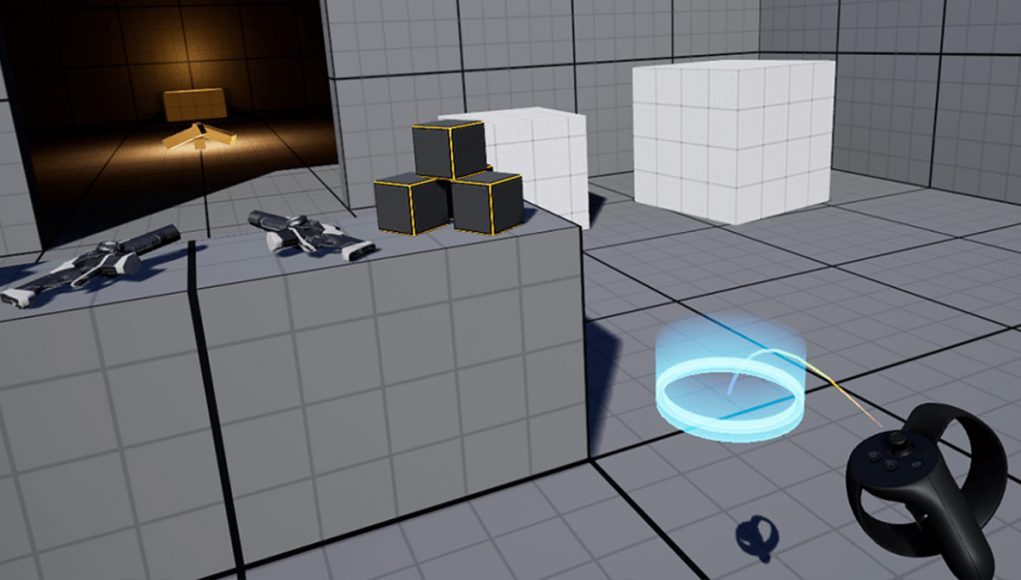The latest version of Unreal Engine 4, version 4.27, brings “production-ready” support for OpenXR. The change comes just in time for Oculus developers, as the company recently announced it’s fully moving open to the OpenXR standard for VR development going forward.
You may recall news back in May that the early access version of Unreal Engine 5 includes improved support for OpenXR. And while developers can play with that version of the engine and its XR tools, the engine’s creator (Epic Games), doesn’t recommend the early access version of Unreal Engine 5 for anything more than experiments at this point. For developers building anything they intend to ship to the public, the company is still recommends Unreal Engine 4.
Since Unreal Engine 5 itself isn’t ready for prime time, Epic Games is continuing to update the production-ready Unreal Engine 4. The latest of which, version 4.27, is the first that the company says includes production-ready OpenXR capabilities.
OpenXR is a royalty-free standard that aims to standardize the development of VR and AR applications, making hardware and software more interoperable. The standard has been in development since April 2017 and is backed by virtually every major hardware, platform, and engine company in the VR industry, including key AR players.
OpenXR has seen a slow but steady adoption since reaching version ‘1.0’ in 2019, and in the last 12 months it has significantly picked up pace with SteamVR officially supported it back in February and Oculus announcing last month that it’s going “all in” on the standard, saying that all new developer features will be built on top of OpenXR going forward.
That makes Unreal Engine 4.27 a timely release; when Oculus said it would be fully shifting to OpenXR development last month, it put XR developers in an odd spot because the two biggest game engines, Unity and Unreal Engine, didn’t yet claim to offer production-ready OpenXR support.
Unity developers will have to wait a while longer before they can confidently make the leap to OpenXR as oculus expects that the Unity OpenXR plugin won’t be “fully supported” until early 2022. That will be a bigger deal once it finally happens because Unity is far and away more used than Unreal Engine when it comes to building XR content.
But maybe developers should take another look… last we checked, Oculus still has a special deal for developers building VR apps with Unreal Engine; the company offers to cover engine royalties for a game’s first $5 million in revenue.
Epic says that the OpenXR support in Unreal Engine 4.27 supports extension plugins from the Unreal Marketplace, which means that developers can add extra OpenXR functionality through plugins rather than waiting for updates to the entire engine.
New VR and AR Development Templates
Unreal Engine 4.27 also adds an improved VR Template which Epic says is “designed to be a starting point for all your VR projects,” and comes with basic VR capabilities built-in, like teleport locomotion, snap rotation, object grabbing, a spectator camera, and a VR-capable menu system.
The VR Template offers support for Oculus Quest 1 & 2, Quest with Oculus Link, Rift S, Valve Index, HTC Vive, and Windows Mixed Reality. Thanks to OpenXR, Epic says that “the template’s logic works on multiple platforms and devices without any platform-specific checks or calls.”
For PC VR, Unreal Engine 4.27 also includes experimental support for fixed foveated rendering, a technique which reduces the quality of peripheral imagery in favor of higher quality at the center where the user can see most sharply through the lens. Fixed foveated rendering in Unreal Engine 4.27 is currently limited to Windows platforms with DX12 and a GPU supporting VRS Tier 2.
Unreal Engine 4.27 also includes a new template for handheld AR development which is designed as a starting point for developers building AR apps based on ARCore (Android) and ARKit (iOS). Similar to the VR template, the AR Template includes basics like a built-in UI, a tool for users to take snapshots of the AR content, and the ability to move, rotate, and scale models places into the world.
 The new engine update further includes heaps of improvements to Unreal Engine’s virtual production tools which are designed to combine real-time CGI environments with live-action filmmaking. Check out the complete patch notes for Unreal Engine 4.27 here if you want to go in-depth.
The new engine update further includes heaps of improvements to Unreal Engine’s virtual production tools which are designed to combine real-time CGI environments with live-action filmmaking. Check out the complete patch notes for Unreal Engine 4.27 here if you want to go in-depth.







